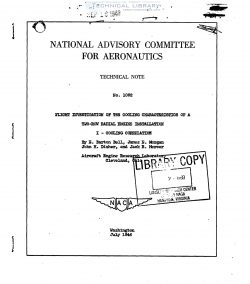naca-tn-1092
- Version
- 119 Downloads
- 1.44 MB File Size
- 1 File Count
- December 2, 2016 Create Date
- December 2, 2016 Last Updated
National Advisory Committee for Aeronautics, Technical Notes - Flight Investigation of the Cooling Characteristics of a Two Row Radial Engine Installation - I - Cooling Correlation

Flight tests have been conducted to determine the cooling
characteristics of a two-row radial engine at altitude in a twin—
engine airplane and to investigate the accuracy with which low»
altitude cooling-correlation eguations can be used for making
cooling predictions at higher altitudes. The test engine was oper-'
ated over a wide range of conditions in level flight at density
altitudes of 5000 and 20,000 feet.
Satisfactory correlation of the cooling variables was obtained
at both altitudes by the NACA cooling-correlation method. By use
of correlation equations developed for specific altitudes, average
engine temperatures could generally be predicted to within i5° F.
When temperatures at an altitude of 20,000 feet were predicted by
correlation equations established at 5000 feet, they were usually
within -lO° F of the actual measured value. Slightly more accurate
results were obtained when the equations were based on the density
of cooling air at the rear of the engine than when they were based
on average or front densities; however, the difference was small for
the range of altitudes encountered.
A relatively simple procedure is followed in this report, which
may be used to evaluate the cooling performance of any conventional
air-cooled power-plant installation and to determine the optimum
conditions of operation for satisfactory cooling and maximum range.
The problems involved in the correlation of important engine
and cooling variables and of predicting cooling performance in flight
have been the subject of many investigations. These investigations
have been based to a great extent, however, on results of cooling
tests made on single-cylinder test units, torque stands, and in
wind tunnels.
Several important factors have prevented making consistently
accurate flight cooling predictions from sea-level cooling tests.
The effects of the greatly different atmospheric conditions existing
at altitude and the accompanying compressibility phenomena are
difficult to account for accurately because of the lack of experiu
mental data. The distribution of cooling air may be greatly different
in flight than in torque-stand tests and the effects of varying _
exhaust pressure further complicate the problem. The distribution
of charge air is also likely to be different because of different
throttle settings and changes in carburetor-entrance conditions owing
to intake-scoop configuration.
| File | Action |
|---|---|
| naca-tn-1092 Flight Investigation of the Cooling Characteristics of a Two Row Radial Engine Installation - I - Cooling Correlation.pdf | Download |

Comment On This Post